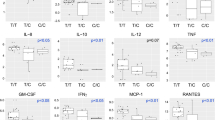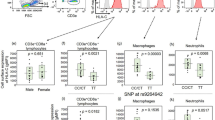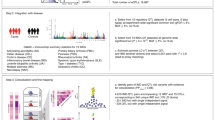Abstract
We analyzed 1,900 Turkish Behçet's disease cases and 1,779 controls genotyped with the Immunochip. The most significantly associated SNP was rs1050502, a tag SNP for HLA-B*51. In the Turkish discovery set, we identified three new risk loci, IL1A–IL1B, IRF8, and CEBPB–PTPN1, with genome-wide significance (P < 5 × 10−8) by direct genotyping and ADO–EGR2 by imputation. We replicated the ADO–EGR2, IRF8, and CEBPB–PTPN1 loci by genotyping 969 Iranian cases and 826 controls. Imputed data in 608 Japanese cases and 737 controls further replicated ADO–EGR2 and IRF8, and meta-analysis additionally identified RIPK2 and LACC1. The disease-associated allele of rs4402765, the lead marker at IL1A–IL1B, was associated with both decreased IL-1α and increased IL-1β production. ABO non-secretor genotypes for two ancestry-specific FUT2 SNPs showed strong disease association (P = 5.89 × 10−15). Our findings extend the list of susceptibility genes shared with Crohn's disease and leprosy and implicate mucosal factors and the innate immune response to microbial exposure in Behçet's disease susceptibility.
This is a preview of subscription content, access via your institution
Access options
Access Nature and 54 other Nature Portfolio journals
Get Nature+, our best-value online-access subscription
$29.99 / 30 days
cancel any time
Subscribe to this journal
Receive 12 print issues and online access
$209.00 per year
only $17.42 per issue
Buy this article
- Purchase on Springer Link
- Instant access to full article PDF
Prices may be subject to local taxes which are calculated during checkout


Similar content being viewed by others
References
Sakane, T., Takeno, M., Suzuki, N. & Inaba, G. Behçet's disease. N. Engl. J. Med. 341, 1284–1291 (1999).
Hatemi, G. et al. EULAR recommendations for the management of Behçet disease. Ann. Rheum. Dis. 67, 1656–1662 (2008).
Verity, D.H., Marr, J.E., Ohno, S., Wallace, G.R. & Stanford, M.R. Behçet's disease, the Silk Road and HLA-B51: historical and geographical perspectives. Tissue Antigens 54, 213–220 (1999).
Gul, A. & Ohno, S. HLA-B*51 and Behçet disease. Ocul. Immunol. Inflamm. 20, 37–43 (2012).
Ono, S., Aoki, K., Sugiura, S., Nakayama, E. & Itakura, K. HL-A5 and Behçet's disease. Lancet 2, 1383–1384 (1973).
de Menthon, M., Lavalley, M.P., Maldini, C., Guillevin, L. & Mahr, A. HLA-B51/B5 and the risk of Behçet's disease: a systematic review and meta-analysis of case–control genetic association studies. Arthritis Rheum. 61, 1287–1296 (2009).
Remmers, E.F. et al. Genome-wide association study identifies variants in the MHC class I, IL10, and IL23R–IL12RB2 regions associated with Behçet's disease. Nat. Genet. 42, 698–702 (2010).
Mizuki, N. et al. Genome-wide association studies identify IL23R–IL12RB2 and IL10 as Behçet's disease susceptibility loci. Nat. Genet. 42, 703–706 (2010).
Kirino, Y. et al. Genome-wide association analysis identifies new susceptibility loci for Behçet's disease and epistasis between HLA-B*51 and ERAP1. Nat. Genet. 45, 202–207 (2013).
Li, H. et al. TNFAIP3 gene polymorphisms confer risk for Behçet's disease in a Chinese Han population. Hum. Genet. 132, 293–300 (2013).
Kirino, Y. et al. Targeted resequencing implicates the familial Mediterranean fever gene MEFV and the toll-like receptor 4 gene TLR4 in Behçet disease. Proc. Natl. Acad. Sci. USA 110, 8134–8139 (2013).
Xavier, J.M. et al. FUT2: filling the gap between genes and environment in Behçet's disease? Ann. Rheum. Dis. 74, 618–624 (2015).
Kappen, J.H. et al. Genome-wide association study in an admixed case series reveals IL12A as a new candidate in Behçet disease. PLoS One 10, e0119085 (2015).
Ortiz-Fernández, L. et al. Genetic analysis with the Immunochip platform in Behçet disease. Identification of residues associated in the HLA class I region and new susceptibility loci. PLoS One 11, e0161305 (2016).
Cortes, A. & Brown, M.A. Promise and pitfalls of the Immunochip. Arthritis Res. Ther. 13, 101 (2011).
Ombrello, M.J. et al. Behçet disease–associated MHC class I residues implicate antigen binding and regulation of cell-mediated cytotoxicity. Proc. Natl. Acad. Sci. USA 111, 8867–8872 (2014).
Hughes, T. et al. Identification of multiple independent susceptibility loci in the HLA region in Behçet's disease. Nat. Genet. 45, 319–324 (2013).
Barland, C.O. et al. Imiquimod-induced interleukin-1α stimulation improves barrier homeostasis in aged murine epidermis. J. Invest. Dermatol. 122, 330–336 (2004).
Vonk, A.G. et al. Endogenous interleukin (IL)-1α and IL-1β are crucial for host defense against disseminated candidiasis. J. Infect. Dis. 193, 1419–1426 (2006).
Liang, L. et al. IL-1β triggered by peptidoglycan and lipopolysaccharide through TLR2/4 and ROS–NLRP3 inflammasome–dependent pathways is involved in ocular Behçet's disease. Invest. Ophthalmol. Vis. Sci. 54, 402–414 (2013).
Kim, E.H., Park, M.J., Park, S. & Lee, E.S. Increased expression of the NLRP3 inflammasome components in patients with Behçet's disease. J. Inflamm. (Lond.) 12, 41 (2015).
Caso, F. et al. Biological treatments in Behçet's disease: beyond anti-TNF therapy. Mediators Inflamm. 2014, 107421 (2014).
Gül, A. et al. Interleukin-1β-regulating antibody XOMA 052 (gevokizumab) in the treatment of acute exacerbations of resistant uveitis of Behçet's disease: an open-label pilot study. Ann. Rheum. Dis. 71, 563–566 (2012).
Ferrer-Admetlla, A. et al. A natural history of FUT2 polymorphism in humans. Mol. Biol. Evol. 26, 1993–2003 (2009).
Franke, A. et al. Genome-wide meta-analysis increases to 71 the number of confirmed Crohn's disease susceptibility loci. Nat. Genet. 42, 1118–1125 (2010).
Hu, D.Y. et al. Associations of FUT2 and FUT3 gene polymorphisms with Crohn's disease in Chinese patients. J. Gastroenterol. Hepatol. 29, 1778–1785 (2014).
Wacklin, P. et al. Secretor genotype (FUT2 gene) is strongly associated with the composition of Bifidobacteria in the human intestine. PLoS One 6, e20113 (2011).
Rausch, P. et al. Colonic mucosa-associated microbiota is influenced by an interaction of Crohn disease and FUT2 (Secretor) genotype. Proc. Natl. Acad. Sci. USA 108, 19030–19035 (2011).
Sheinfeld, J., Schaeffer, A.J., Cordon-Cardo, C., Rogatko, A. & Fair, W.R. Association of the Lewis blood-group phenotype with recurrent urinary tract infections in women. N. Engl. J. Med. 320, 773–777 (1989).
Marionneau, S., Airaud, F., Bovin, N.V., Le Pendu, J. & Ruvoën-Clouet, N. Influence of the combined ABO, FUT2, and FUT3 polymorphism on susceptibility to Norwalk virus attachment. J. Infect. Dis. 192, 1071–1077 (2005).
Rupp, C. et al. Fut2 genotype is a risk factor for dominant stenosis and biliary candida infections in primary sclerosing cholangitis. Aliment. Pharmacol. Ther. 39, 873–882 (2014).
Hatemi, I. et al. Frequency of pathergy phenomenon and other features of Behçet's syndrome among patients with inflammatory bowel disease. Clin. Exp. Rheumatol. 26 (Suppl. 50), S91–S95 (2008).
Jostins, L. et al. Host–microbe interactions have shaped the genetic architecture of inflammatory bowel disease. Nature 491, 119–124 (2012).
Zhang, F.R. et al. Genomewide association study of leprosy. N. Engl. J. Med. 361, 2609–2618 (2009).
Liu, H. et al. Discovery of six new susceptibility loci and analysis of pleiotropic effects in leprosy. Nat. Genet. 47, 267–271 (2015).
Sales-Marques, C. et al. NOD2 and CCDC122–LACC1 genes are associated with leprosy susceptibility in Brazilians. Hum. Genet. 133, 1525–1532 (2014).
Wakil, S.M. et al. Association of a mutation in LACC1 with a monogenic form of systemic juvenile idiopathic arthritis. Arthritis Rheumatol. 67, 288–295 (2015).
Patel, N. et al. Study of Mendelian forms of Crohn's disease in Saudi Arabia reveals novel risk loci and alleles. Gut 63, 1831–1832 (2014).
Cader, M.Z. et al. C13orf31 (FAMIN) is a central regulator of immunometabolic function. Nat. Immunol. 17, 1046–1056 (2016).
Screpanti, I. et al. Lymphoproliferative disorder and imbalanced T-helper response in C/EBPβ-deficient mice. EMBO J. 14, 1932–1941 (1995).
Tanaka, T. et al. Targeted disruption of the NF-IL6 gene discloses its essential role in bacteria killing and tumor cytotoxicity by macrophages. Cell 80, 353–361 (1995).
Zierhut, M. et al. Immunology and functional genomics of Behçet's disease. Cell. Mol. Life Sci. 60, 1903–1922 (2003).
Criteria for diagnosis of Behçet's disease. International Study Group for Behçet's Disease. Lancet 335, 1078–1080 (1990).
Mizushima, Y. Recent research into Behçet's disease in Japan. Int. J. Tissue React. 10, 59–65 (1988).
Price, A.L. et al. Long-range LD can confound genome scans in admixed populations. Am. J. Hum. Genet. 83, 132–135 author reply 135–139 (2008).
Purcell, S., Cherny, S.S. & Sham, P.C. Genetic Power Calculator: design of linkage and association genetic mapping studies of complex traits. Bioinformatics 19, 149–150 (2003).
Jia, X. et al. Imputing amino acid polymorphisms in human leukocyte antigens. PLoS One 8, e64683 (2013).
Marchini, J., Howie, B., Myers, S., McVean, G. & Donnelly, P. A new multipoint method for genome-wide association studies by imputation of genotypes. Nat. Genet. 39, 906–913 (2007).
Delaneau, O., Marchini, J. & Zagury, J.F. A linear complexity phasing method for thousands of genomes. Nat. Methods 9, 179–181 (2011).
Skol, A.D., Scott, L.J., Abecasis, G.R. & Boehnke, M. Joint analysis is more efficient than replication-based analysis for two-stage genome-wide association studies. Nat. Genet. 38, 209–213 (2006).
Abecasis, G.R. et al. A map of human genome variation from population-scale sequencing. Nature 467, 1061–1073 (2010).
Ward, L.D. & Kellis, M. HaploReg: a resource for exploring chromatin states, conservation, and regulatory motif alterations within sets of genetically linked variants. Nucleic Acids Res. 40, D930–D934 (2012).
Adzhubei, I.A. et al. A method and server for predicting damaging missense mutations. Nat. Methods 7, 248–249 (2010).
Yang, T.P. et al. Genevar: a database and Java application for the analysis and visualization of SNP–gene associations in eQTL studies. Bioinformatics 26, 2474–2476 (2010).
Grundberg, E. et al. Mapping cis- and trans-regulatory effects across multiple tissues in twins. Nat. Genet. 44, 1084–1089 (2012).
Westra, H.J. et al. Systematic identification of trans eQTLs as putative drivers of known disease associations. Nat. Genet. 45, 1238–1243 (2013).
Baran, Y. et al. The landscape of genomic imprinting across diverse adult human tissues. Genome Res. 25, 927–936 (2015).
Dennis, G. Jr. et al. DAVID: Database for Annotation, Visualization, and Integrated Discovery. Genome Biol. 4, 3 (2003).
Acknowledgements
This research was supported by the Intramural Research Programs of the National Human Genome Research Institute and the National Institute of Arthritis and Musculoskeletal and Skin Diseases. We thank all the patients, the healthy controls, and medical staff for their enthusiastic support during this research study. M.T. is supported by a Fellowship for Japanese Biomedical and Behavioral Researchers at the NIH from the Japan Society for the Promotion of Science Research and a grant from the Japan Foundation for Applied Enzymology. Y.K. is supported by grants from the Japan Society for the Promotion of Science Grant-in-Aid for Scientific Research (grant 26713036), the Kanae Foundation for the Promotion of Medical Science, the Takeda Science Foundation, the SENSHIN Medical Research Foundation, and the Yokohama Foundation for Advancement of Medical Science. This research was also supported by the Portuguese Fundação para a Ciência e a Tecnologia (grant CMUP-ERI/TPE/0028/2013, fellowship SFRH/BPD/70008/2010 to I.S., and an Investigator-FCT contract to S.A.O.) and the Research Committee of the Tehran University of Medical Sciences (grant 132/714). We thank A.F. Wilson for insightful comments on this manuscript.
Author information
Authors and Affiliations
Contributions
M.T., M.J.O., A.G., D.L.K., and E.F.R. designed the study. M.T., A.M., M.J.O., M.B., M.G., A.G., D.L.K., and E.F.R. carried out the analysis. M.T., N.M., A.M., M.J.O., Y.K., C.S., J.L., M.B., B.E., T.K., D.U., I.T.-T., E.S., Y.O., I.S., F.D., V.F., F.S., B.S.A., A.N., N.M.S., F.G., S.O., A.U., Y.I., M.G., S.A.O., A.G., D.L.K., and E.F.R. procured samples and generated data. M.T., M.J.O., M.B., M.G., A.G., D.L.K., and E.F.R. wrote the manuscript. All authors read and approved the final version of the manuscript.
Corresponding authors
Ethics declarations
Competing interests
The authors declare no competing financial interests.
Supplementary information
Supplementary Text and Figures
Supplementary Figures 1–7 and Supplementary Tables 1–21 (PDF 2510 kb)
Supplementary Data Set
Immunochip statistical summary data set (TXT 655 kb)
Rights and permissions
About this article
Cite this article
Takeuchi, M., Mizuki, N., Meguro, A. et al. Dense genotyping of immune-related loci implicates host responses to microbial exposure in Behçet's disease susceptibility. Nat Genet 49, 438–443 (2017). https://doi.org/10.1038/ng.3786
Received:
Accepted:
Published:
Issue Date:
DOI: https://doi.org/10.1038/ng.3786
This article is cited by
-
Behçet’s Disease as a Canker Sore: MHC-I-Opathy Versus Behcet’s Spectrum Disorders
Current Oral Health Reports (2024)
-
Functions of the RIP kinase family members in the skin
Cellular and Molecular Life Sciences (2023)
-
Transcriptome analysis of immune cells from Behçet’s syndrome patients: the importance of IL-17-producing cells and antigen-presenting cells in the pathogenesis of Behçet’s syndrome
Arthritis Research & Therapy (2022)
-
Progress in the genetics of uveitis
Genes & Immunity (2022)
-
Lupus enhancer risk variant causes dysregulation of IRF8 through cooperative lncRNA and DNA methylation machinery
Nature Communications (2022)



